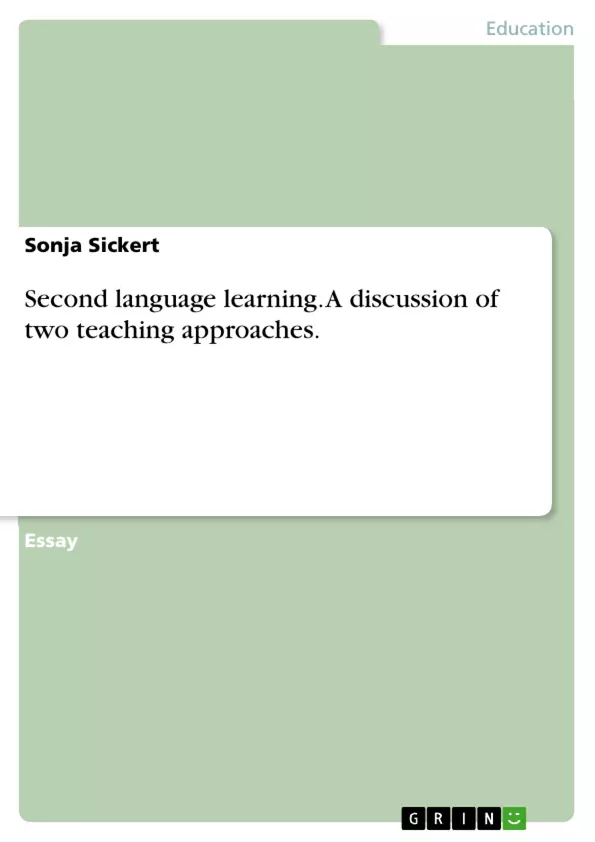The first attempts of teaching a foreign language were derived from teaching Latin in the sixteenth to eighteenth century. After the decline of Latin as a living language, the main teaching aim was to read and understand historic Latin writings. This situation led to teaching grammar and vocabulary through rote learning. The study of Latin grammar was known to encourage intellectual abilities. Applied to teaching methods in the nineteenth century the Grammar-Translation Method emerged. Since the eighteenth century, foreign language teaching has increased in importance. As modern languages conquer the school schedules in Europe the lessons were based on experience of teaching Latin and the same method was used to teach modern languages. Oral speaking abilities were just used to read aloud the translation they had dealt with. The main exercise was translation from foreign language into mother tongue with the objective to comprehend and learn the different grammar structure between these languages. The Grammar-Translation method became the traditional teaching method from the nineteenth century onwards.
Inhaltsverzeichnis (Table of Contents)
- Introduction
- Grammar-Translation method in past
- The method
- Grammar-Translation method in present
- Communicative Language Teaching (or Communicative-Approach or Functional Approach)
Zielsetzung und Themenschwerpunkte (Objectives and Key Themes)
This essay aims to provide a comparative analysis of two prominent approaches to second language teaching: the Grammar-Translation method and the Communicative Language Teaching method. By examining the historical context, core principles, and strengths and weaknesses of each approach, the essay aims to shed light on their suitability for learners in modern language learning environments.
- Historical development of second language teaching methods
- Comparison of the Grammar-Translation method and Communicative Language Teaching
- The role of grammar and communication in language acquisition
- The impact of the shift from a focus on linguistic competence to communicative competence
- The relevance of second language learning in contemporary society
Zusammenfassung der Kapitel (Chapter Summaries)
- Introduction: This introductory section establishes the growing significance of second language proficiency in contemporary society and highlights the importance of efficient language acquisition. It introduces the two teaching approaches, the Grammar-Translation method and Communicative Language Teaching, which will be discussed in detail.
- Grammar-Translation method in past: This section traces the historical roots of the Grammar-Translation method, starting with the teaching of Latin in the 16th to 18th centuries. It explains how the focus shifted from conversational fluency to reading and understanding historical texts, leading to the development of the Grammar-Translation method in the 19th century.
- The method: This section delves into the core principles of the Grammar-Translation method, highlighting its emphasis on grammar rules and translation exercises. It discusses its limitations in terms of listening comprehension and communicative ability, as well as criticisms regarding its potential to create frustration among learners.
- Grammar-Translation method in present: This section examines the continued presence of the Grammar-Translation method in contemporary language teaching, despite its perceived limitations. It explores how the method is often adapted and applied in various educational contexts, including schools and universities.
- Communicative Language Teaching (or Communicative-Approach or Functional Approach): This section introduces the rise of Communicative Language Teaching in the 1970s as a response to the growing need for spoken language proficiency. It emphasizes the shift from linguistic competence to communicative competence, highlighting the importance of actually speaking the language rather than simply knowing its structure.
Schlüsselwörter (Keywords)
This essay explores the key concepts of second language learning, focusing on the contrasting approaches of Grammar-Translation and Communicative Language Teaching. It examines historical development, grammatical focus, communicative competence, and the evolving landscape of language teaching in modern educational settings. The essay highlights the importance of considering both linguistic and communicative aspects in the acquisition of a foreign language, particularly in today's globalized world.
- Quote paper
- Sonja Sickert (Author), 2005, Second language learning. A discussion of two teaching approaches. , Munich, GRIN Verlag, https://www.grin.com/document/62730



